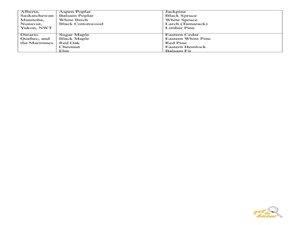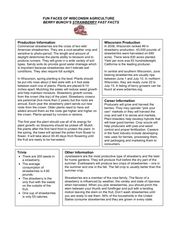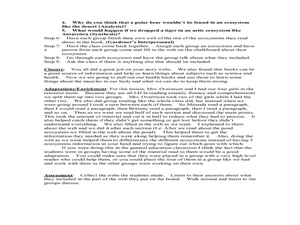Curated OER
Cyclone!
In this cyclones worksheet, students watch a video and answer 20 questions about specific hurricanes that have occurred and their damage, the parts of a hurricane, the difference between tornadoes and hurricanes and the speed of winds.
Curated OER
Get to Know Trees
Students recognize the characteristics of trees by using their five senses. In this trees instructional activity, students observe and record the characteristics of trees on a field trip. Students then are blindfolded and use their...
Curated OER
Guetemala's Changing Forest
Eighth graders compare their local ecological zone to the tropical rainforest. In this natural ecology instructional activity, 8th graders complete an activity about the differences in ecological zones. They compare their biome to the...
Curated OER
Fun Faces of Wisconsin Agriculture: Berry Bunch's Strawberry Fast Facts
Students use facts about strawberry production in Wisconsin to complete math and art activities. For this strawberry production lesson, students read about strawberry production in the state of Wisconsin. They answer math word problems...
Curated OER
Keep In Touch: Communications and Satellites
Fourth graders explore communications by reading assigned space science text. In this satellite lesson, 4th graders identify the concept of orbiting and examine gravitational pull by viewing diagrams. Students are assessed based on...
Curated OER
Do Fast CMEs Produce Intense SPEs?
In this coronal mass ejections and Solar Proton Events activity, students create a Venn Diagram to represent given data. They answer 5 questions about the data related to the number of coronal mass ejections and Solar Proton Events...
Curated OER
Sleet and Hail Have Their Own Seasons
Second graders explain the definition of hail and sleet. For this precipitation lesson, 2nd graders discuss when hail and sleet fall and the results of hail falling.
Curated OER
Jackie Gore
Students identify the amount of heat given off by solar energy. In this solar energy lesson, students complete an experiment using soil and sand measuring the heat from solar energy.
Curated OER
Sustainable Southern Belize: Coral Health Lesson Plan
Fifth graders investigate coral reefs and the dangers they face by labeling and drawing. In this oceanography lesson, 5th graders view a PowerPoint presentation of photographs of coral reefs in Belize. Students investigate...
Curated OER
The Environment and Pollution
In this pollution and the environment activity, students complete matching and fill-in-the-blank questions associated with pollution. Some though-provoking conversation starters are embedded in the plan to help the students discuss the...
Curated OER
Trees: Are They Thriving or Surviving?
In this trees survival lesson plan, 8th graders discuss what trees need to grow, brainstorm things that could adversely affect tree growth, and compare characteristics of thriving trees vs. surviving trees. Students learn about the...
Curated OER
Outdoor Survival
Young scholars are introduced to basic outdoor survival concepts. They identify the seven basic needs for survival. Students describe the symptoms and treatment for frostbite and hypothermia. They compare and contrast the value of...
Curated OER
Regolith Formation
Students compare and contrast the process of regolith formations. In groups, students define regolith and discover how regolith is formed on the Earth and on the Moon. They participate in experimental activities to simulate regolith.
Curated OER
Graphic Organizers Aid Comprehension
Students create story webs to aid comprehension of ecosystems. In this reading strategies lesson, students discover the importance of organizing information while reading a nonfiction text. Students produce story webs to communicate...
Curated OER
Milkweed Monitoring
Ninth graders study milkweed and see how it is effected by ozone. In this air pollution lesson students complete a lab activity that includes data analysis.
Curated OER
What is a Wetland?
In this Tyson Lagoon wetland worksheet, students record their observations during a field trip to a constructed wetland area. They make observations at 6 stations, trace the water flow through the ecosystem and examine the soil and plants.
Curated OER
Science Experiments - The Low-down
Third graders discover the process thinking about science experiments, and why they are important. They work in small groups using incline planes and a small toy car to design one scientific question that can be answered through...
Curated OER
Total English Upper Intermediate: Question Time!
In this relationship key vocabulary worksheet, learners unscramble 8 groups of words to form questions, write a description of an unusual place, and write 6 questions about the place they chose.
Curated OER
Counting Principle
In this probability and statistics instructional activity, students work with a family member to determine the number of outcomes in a given situation. The two page instructional activity contains four...
Curated OER
Modal Verbs Of Obligation
In this modal verbs of obligation worksheet, students choose the correct form of the modal verbs in both the positive or negative form, then write their own sentences.
Curated OER
Solar Box Cooker
Learners explore solar power. In this solar power lesson plan, students build simple solar cookers after they study convection, conduction, and radiation. Learners transfer their knowledge of how the solar cooker works to climate changes...
Curated OER
Where Do Animals Live?
Students c;assify where pets live and where wild animals live and comprehend the differences. They investigate what kinds of homes pets and wild animals need. Students bring in a stuffed animal or puppet from home and match their...
Curated OER
Total English Upper Intermediate: Traveling and Going Places
For this travel key vocabulary worksheet, students complete 8 sentence starters and evaluate 3 descriptions of holidays in order to write about their ideal companions for each.
Curated OER
Do you know your Hats Quiz
In this hats worksheet, students look at pictures of hats and choose which name fits the hat best. Students complete 20 multiple choice questions.























